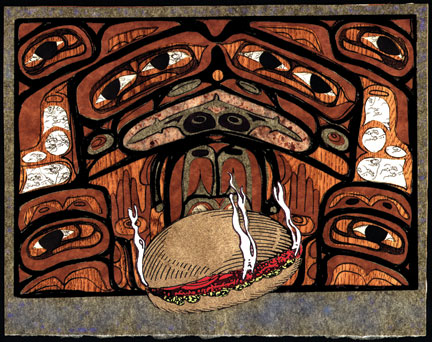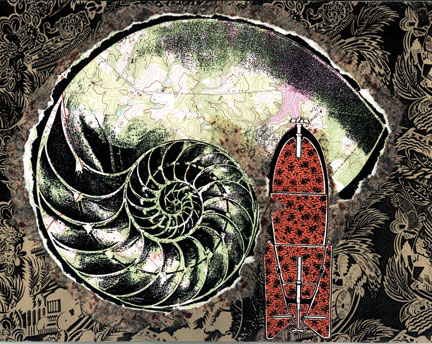|
|
“It
takes six thousand gallons of freshwater to raise 1 pound of
beef.” Image courtesy of Christy Rupp
|
|
“In
peacetime, the military generates 1 ton of toxic waste per minute.”
Image courtesy of Christy Rupp |
Since the 1970s, New York based artist Christy
Rupp has been creating art that takes a critical look at the social
and environmental impact
of human actions. Her early work—inspired by animal behavior—included
projects on the rodents and roaches we share our cities with. In recent
years, she has been focusing on the commodification and manipulation
of nature, labeling of genetically modified foods, and biopiracy. Issues
around water and toxins also permeate her work. Her Red Tide exhibit
featured turtle sculptures made from the items that destroy their habitat—detergent
bottles. She has also been involved in many public art projects in
cities around the country.
With parody and wit, Christy Rupp recently branded herself as the corporation
Lowgo Global Life Sciences conveying the harms of globalization with the motto “We
make messes.” Sangamithra Iyer had a chance to ask Christy
Rupp about her
art, the single-celled universe, and the links between Roe v. Wade and the Endangered
Species Act.
How would you describe your art and what mediums do you use?
It has been a focus on the intersection of economics and the environment. Materials
have included recycled or green materials, as well as anything that would hold
them together. I am also very interested in off-the-grid, or traditional ways
of working, like gas welding with steel and flame working with glass.
Your work explores the social costs of environmental disruption. Can
you tell
us a bit about this and some of the issues you’ve incorporated into your
art?
I have been interested in making a physical connection to ideas. For instance,
looking at the appearance of toxic molecules, or what a virus looks like. What
do pathogens in tap water look like? Are they [natural] or manufactured in an
effort to sanitize? How does a genetically engineered pesticide really change
the anatomy of insects who selectively evolve tolerance to poison? Mostly I am
trying to understand how humans fit into the cycle, accelerating entropy as we
consume. I am fascinated by the “Terra Nullis” or empty earth viewpoint—that
phenomena are owned by their discoverers, even if those discoverers have no hand
in the creation. It’s also fascinating how much easier it is to destroy
an ecosystem than to control it.
A couple of years ago, I started to read about the effects of globalization,
NAFTA, and the approaching CAFTA accords. I have been trying to make this process
of fragmentation visible by parodizing a corporation, using images and text to
create a phony company.
Could you tell us about your brand Lowgo Global Life Sciences and why you chose
to feature a protozoan on your logo?
Recently I decided to become obsolete as a human, due to racism, greed and war.
Because art is so often regarded as a commodity, it made sense to call myself
a brand, so at least I could continue working. I met with Vivian Verlaan, a young
graphic artist trained in the science of branding, and she helped me come up
with Lowgo. We based it on the exploration of how market forces are affected
or not affected by natural forces. Can greed stand up to Gaia? Is the corporation
really a single-celled organism, which can detach itself from the cycle thereby
enhancing its own wealth? Or is marketing a shabby excuse for a shortsighted
lack of participation in a healthy tomorrow?
You’ve been involved in several public art projects. I was wondering
if
you could explain your Roll Back Bench, and how it links Roe v. Wade and the
Endangered Species Act? Also can you tell us about your work with the Coney Island
Water Pollution Control Plant?
Roll Back Bench was commissioned in 1992 by the University of Washington, Seattle,
as a monument to 20 years of endangered species legislation. At the time, the
Endangered Species Act was before Congress for re-authorization. The bill was
being challenged by anti-environmentalists who had targeted the spotted owl as
a harbinger of economic doom for Northwest lumber interests. By saying that each
spotted owl took away 40,000 jobs, they were framing the debate in much the same
way anti-choice groups equate freedom of choice with murder. The Endangered Species
Act preserves the entire ecosystem, including spotted owl habitats, much the
same way Roe v. Wade preserves a larger context of options, only one of which
is abortion. Both acts were passed in 1972 to protect civil rights, and both
continue to be challenged. The actual sculpture was a cement couch in the shape
of a dam. You can sit in the sculpture and reflect on your position in the debate,
while two large stainless steel salmon try to get by the obstruction you have
become. “Roll-back” is a term referring to the style of couch as
well as a reversion to the past.
“Tidal Filter Fence” is the project designed through the NYC Percent
for Art Program, in collaboration with the Department of Environmental Protection,
at the Coney Island Water Pollution Control Plant. It is a pedestrian and public
access fishing pier at the site of the plant, abutting a wetland, which has now
become a boat basin. The dock-like structure takes its form from the tidal movement
and is colonized by barnacle shaped lighting fixtures, Mussel Benches and a “Catch
My Drift” picnic table. It uses graywater and rain runoff to irrigate beach
grasses surrounding the structure. The idea for the piece is that a healthy wetland
performs the same function as the sewage treatment facility, and it advocates
a greener approach than massive chemical treatment. It has never been constructed
or cancelled, but lingers in denial much the way our development policies are
in denial about the future.
Why is public art important?
Public art is important because it is a voice outside the system. It should raise
questions by making people confront their anxiety and create dialogue.
What are you working on currently?
At the moment I’m interested in the theory of evolution, the way it is
being challenged intellectually and in the domain of public education. I have
decided to recreate some endangered species of birds, constructing them from
hormone and pesticide-laden chicken bones gathered from fast food outlets. This
is inspired by the science of genetic engineering, the idea that we can have
whatever we want by reducing an organism to the sum of its parts, and then reassembling
at will to fit our needs.
What role do you think art plays in activism?
Activism comes from everywhere. Hopefully artists can contribute a sense of visual
richness or ideas, creating new ways to imagine the struggle, and an environment
of inclusivity because so many people are visual, and words can exclude those
who speak different languages or don’t read.
To learn more, visit www.christyrupp.com.
 |
|
|
 |


